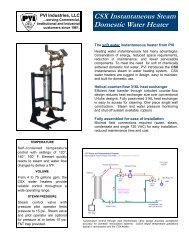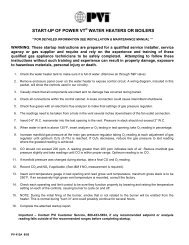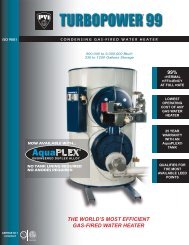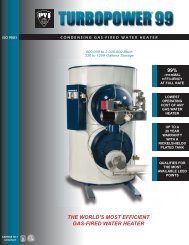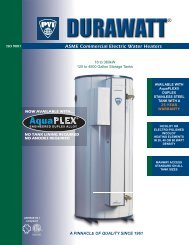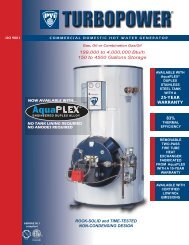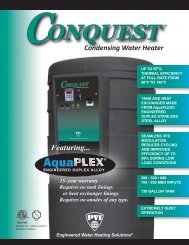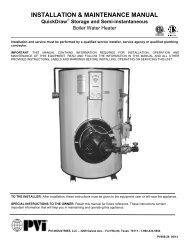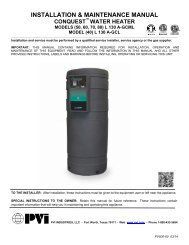installation & maintenance manual maxim 3 - Pvi.com
installation & maintenance manual maxim 3 - Pvi.com
installation & maintenance manual maxim 3 - Pvi.com
Create successful ePaper yourself
Turn your PDF publications into a flip-book with our unique Google optimized e-Paper software.
MAXIM 3 ® WATER HEATER<br />
19. When the blower motor starts, the flame control will check for a positive air flow. If the air switch or blocked<br />
filter switch is not made the blower will stay on for a period of time then lockout. To adjust the air-proving<br />
switch, turn the adjustment screw counter-clockwise until the air proving light <strong>com</strong>es on, then turn the screw<br />
one turn counter-clockwise. The blocked filter switch should only be adjusted when the filter is new. This<br />
switch should be turned clockwise until switch makes and then two additional turns. If the gas valves open<br />
and close intermittently during normal operation, adjust pressure switches to increase the operational<br />
threshold until this condition ceases. This procedure should be followed with every burner.<br />
20. After the pre-purge, the flame control energizes the HSI for the heat up period, approximately 30 seconds. At<br />
the end of that period the gas valve is opened for approximately 4 seconds. After the burner has lit and the<br />
primary safety control senses a flame, the burner will remain on until the call for heat is satisfied or operation<br />
is interrupted by a safety device.<br />
21. If the burner fails to light, the flame control will lockout. When this happens press the reset button on the front<br />
of the control to recycle burner and check for improper <strong>com</strong>bustion or week flame signal as a possible cause.<br />
22. Once the main burner flame is established the firing rate will be controlled by the TempTrac control. Refer to<br />
TempTrac <strong>manual</strong> PV500-41.<br />
Burner Combustion Adjustment<br />
Burner <strong>com</strong>bustion should only be adjusted using a <strong>com</strong>bustion analyzer. Do not attempt to adjust burner by<br />
sound or sight. With the burner firing, insert the <strong>com</strong>bustion analyzer probe in the flue vent approximately two<br />
feet from the appliance. See Gas Train Illustration below for details.<br />
With the burner firing and adjusted to low fire, adjust the regulator screw clockwise to increase gas flow or<br />
counter clockwise to decrease flow. The desired CO 2 in the <strong>com</strong>bustion products should be between 8.0 and<br />
9.0% for natural gas, 9.5% to 10.5% for LP gas. Do not attempt to adjust <strong>com</strong>bustion based on manifold<br />
pressure alone. Manifold pressure should only be used as a reference point.<br />
a. Once the desired <strong>com</strong>bustion is achieved at low fire, raise the burner firing rate to high fire. Adjust the<br />
valve orifice clockwise to reduce the flow of gas and counter-clockwise to increase the flow of gas in order<br />
to maintain the desired CO 2 in the <strong>com</strong>bustion products between 8.0 and 9.0% for natural gas, 9.5% to<br />
10.5% for LP gas.<br />
b. When high fire <strong>com</strong>bustion has been reached and <strong>com</strong>bustion is within the proper range, return to low fire<br />
to confirm settings again.<br />
c. CAUTION: If at any point carbon monoxide is in excess of 300ppm, contact PVI Industries<br />
customer service for assistance.<br />
23. Enable or reconnect any BMS/BAS control interface removed prior to the setup and adjustment of each water<br />
heater.<br />
26<br />
PV500-51 03/14




